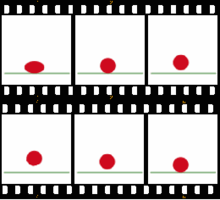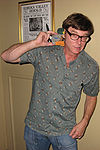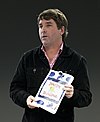
| Main | Categories and topics | Tasks and projects |
Introduction
Animation is a filmmaking technique by which still images are manipulated to create moving images. In traditional animation, images are drawn or painted by hand on transparent celluloid sheets (cels) to be photographed and exhibited on film. Animation has been recognized as an artistic medium, specifically within the entertainment industry. Many animations are computer animations made with computer-generated imagery (CGI). Stop motion animation, in particular claymation, has continued to exist alongside these other forms.
Animation is contrasted with live-action film, although the two do not exist in isolation. Many moviemakers have produced films that are a hybrid of the two. As CGI increasingly approximates photographic imagery, filmmakers can easily composite 3D animations into their film rather than using practical effects for showy visual effects (VFX). (Full article...)
Selected article
"Ride Me to Hell" is the third episode of the second season of the American animated television series Ugly Americans, and the seventeenth overall episode of the series. It originally aired on Comedy Central in the United States on July 14, 2011. In the episode, Grimes is outraged by the unsatisfying ending of his favorite television series, and Mark helps him unravel his attachment to the series while uncovering several deep-seated memories. Meanwhile, Callie is expected to take over as the leader of Hell from her father, but is unwilling to do so. The episode was written by Mike Rowe and directed by Aaron Augenblick and series creator Devin Clark. While the series' first season mainly referenced horror films, "Ride Me to Hell" pays homage to 1970s cop shows. Clark used Grimes unleashing his memories from the 1970s as an opportunity to parody cop shows such as CHiPs and Starsky and Hutch. According to Nielsen Media Research, "Ride Me to Hell" was watched by 814,000 viewers in its original airing, a slight drop in total viewership when compared to previous episodes. The episode received positive reviews.
Selected image
Did you know (auto-generated) -

- ... that the stylized animation of Teenage Mutant Ninja Turtles: Mutant Mayhem was inspired by rough sketches in school notebooks?
- ... that Raoul Servais invented a new technique for combining animation and live action for his short film Harpya?
- ... that at age 12, Shaylee Mansfield became the first deaf actor to be credited alongside the voice actors for a signed performance in an animated production?
- ... that the creators of the cartoon Jade Armor filmed live-action martial arts stunts to visualize the show's animated action sequences?
- ... that, for the animated film Us Again, director and writer Zach Parrish considered a video of an elderly couple dancing to be visceral and ideal inspiration?
- ... that the Pakistani film Shehr e Tabassum was the first animated cyberpunk film to be made by an Urdu development team?
Selected quote
Selected biography
William Denby "Bill" Hanna (July 14, 1910 – March 22, 2001) was an American animator, director, producer, television director, television producer, and cartoon artist, whose movie and television cartoon characters entertained millions of fans worldwide for much of the 20th century. During the 1930s, Hanna steadily gained skill and prominence while working on cartoons such as Captain and the Kids. In 1937, while working at Metro-Goldwyn-Mayer (MGM), Hanna met Joseph Barbera. The two men began a collaboration that was at first best known for producing Tom and Jerry and live action films. In 1957, they co-founded Hanna-Barbera, which became the most successful television animation studio in the business, producing programs such as The Flintstones, The Huckleberry Hound Show, The Jetsons, Scooby-Doo, The Smurfs, and Yogi Bear. In 1967, Hanna–Barbera was sold to Taft Broadcasting for $12 million, but Hanna and Barbera remained heads of the company until 1991. At that time the studio was sold to Turner Broadcasting System, which in turn was merged with Time Warner, owners of Warner Bros., in 1996; Hanna and Barbera stayed on as advisors. Hanna and Barbera won seven Academy Awards and eight Emmy Awards.
Selected list
The episodes of SpongeBob SquarePants, an American animated television series created by marine biologist and animator Stephen Hillenburg (pictured) for Nickelodeon. Since its debut on May 1, 1999, 268 episodes of the series have been broadcast; its ninth season premiered on July 21, 2012. The series is set in the fictional underwater city of Bikini Bottom, and centers on the adventures of SpongeBob SquarePants (Tom Kenny), an over-optimistic sea sponge that annoys other characters. Many of the ideas for the show originated in an unpublished, educational comic book titled The Intertidal Zone, which Hillenburg created in 1984. He began developing SpongeBob SquarePants into a television series in 1996 upon the cancellation of Rocko's Modern Life. SpongeBob SquarePants has been noted for its appeal towards different age groups. During the second season, it became Nickelodeon's No. 2 children's program, after Rugrats. Nearly 40 percent of its audience of 2.2 million were aged 18 to 34. In season three, SpongeBob SquarePants passed Rugrats and earned the title of being the highest rated children's show on cable.
More did you know...
- ...that the designers of Cabbage Patch Kids created Selchow and Righter's Scrabble People, the title characters of 1985's syndicated cartoon special A Pumpkin Full of Nonsense?
- ...that Monty Oum, the creator of Rooster Teeth Productions' upcoming series RWBY, was concerned that the show focused on female characters but was being developed by a mostly male crew?
- ...that during his 64-year career, animator Bob Givens created the first official design for Bugs Bunny?
Anniversaries for July 18
- Films released
- 1920 - Felix and the Feed Bag (United States)
- 1927 - Wild Rivals (United States)
- 1932 - Mickey in Arabia (United States)
- 1936 - I Love to Singa (United States)
- 1942 - The Bowling Alley Cat (United States)
- 1952 - Uncle Donald's Ants (United States)
- 1959 - Tweet and Lovely (United States)
- 1956 - Jack and Old Mac (United States)
- 1971 - Pink Blue Plate (United States)
- 2014 - Planes: Fire & Rescue (Pixar, Walt Disney Pictures, United States)
- Deaths
- 1992 – Rudolph Ising, American cartoon animator (b. 1903)
Subportals
Related portals
Wikimedia
The following Wikimedia Foundation sister projects provide more on this subject:
-
 Commons
Commons
Free media repository -
 Wikibooks
Wikibooks
Free textbooks and manuals -
 Wikidata
Wikidata
Free knowledge base -
 Wikinews
Wikinews
Free-content news -
 Wikiquote
Wikiquote
Collection of quotations -
 Wikisource
Wikisource
Free-content library -
 Wikiversity
Wikiversity
Free learning tools -
 Wiktionary
Wiktionary
Dictionary and thesaurus
















